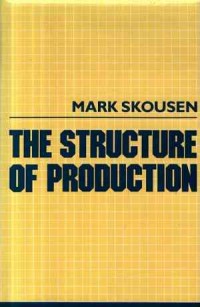
| Dane szczegółowe: | |
| Wydawca: | New York University Pres |
| Oprawa: | twarda |
| Ilość stron: | 416 s. |
| Wymiar: | 160x240 mm |
| EAN: | 9780814778951 |
| ISBN: | 0-8147-7895-X |
| Data: | 2005-12-29 |
Opis książki:
In The Structure of Production, Professor Mark Skousen makes the challenging case for a new macroeconomics. The author contends that Keynesian and monetarist models are not "generał" theories of the macro economy, but are incomplete and therefore flawed theories because they ignore the critical role of time in the production process.
In their place, Skousen recommends a uniyersal macroeconomic model based on the idea that all goods and seryices involve lengthy stages of processing, taking months, if not years, to reach their ultimate consumer use.
In making extensive use of this time-structural model of the economy, Skousen presents several surprising and provocative conclusions:
• Gross National Product (GNP) is a narrow and often misleading representation of economic activity. Skousen shows that GNP significantly exaggerates the role of consumer spending in the economy at the expense of investment, which has led to much mischief in goyernment policy decisions. In its place, Skousen creates a new statistic, Gross National Output (GNO), which accurately reflects total spending by business, consumers, and government. He concludes that gross investment by business is significantly larger than consumer expenditures.
• The author demonstrates the fallacy of the "paradox of thrift," the Keynesian notion that an increase in savings is detrimental in an unemployed economy. By imposing a dynamie, timeoriented approach on the Keynesian model, Skousen shows why countries that have adopted high rates of savings have achieved the highest rates of economic growth.
• A time-structural approach to economics provides a natural link between microeconomics and macroeconomics for the first time. Skousen`s time-structural model is a disaggregative "halfway house" between micro and macro. While standard "neoclassical" models stress the generał price level and total output, the time-structural model emphasizes relatwe changes in prices, production, and inventories at each stage of processing, thus interrelating the various sectors of the economy to one another (extractive, manufacturing, wholesaling, and retailing).
• The dynamie use of this new time-structural model demonstrates how inflationary recession can occur. Skousen`s diagrams also show how commodity prices and producer prices can fali while consumer prices continue to rise (and vice versa). Standard aggregate demand and aggregate suppły curves cannot demonstrate this phenomenon.
• Using the time-structural model, the author offers a thorough critique of yarious government policies and their effects on the economy, including deficit spending, monetary inflation, and tax reductions. Hę also contrasts the effects of a "consumption-oriented" inflation with a "business-credit" inflation. Finally, Skousen anałyzes the surprising benefits and potential hazards of returning to a pure gold standard.
Skousen`s treatise includes other outstanding features, such as a resolution of the debate over the validity of Say`s Law, .a new version of aggregate suppły and demand, and an explanation of how to appły the time-structural model to the financial markets and investment decisions. The book also devotes three chapters to the most thorough-going history ever written of the time-structural approach in economics.
MARK SKOUSEN is Adjunct Professor of Economics and Finance at Rollins College in Winter Park, Florida, He is the author of ten books on economic and financial subjects, including The Complete Guide to Financial Prwacy, Playing the Price Controls Gamę, and The Economics ofa Pure Gold Standard. Hę is the editor of Forecasts and Strategies, one of the largest investment letters in the United States.
Książka "The structure of production" - Mark Skousen - oprawa twarda - Wydawnictwo New York University Pres.
Spis treści:
1. Introduction: The Case for a New Macroeconomics
PART l
THE STRUCTURE OF PRODUCTION: A HISTORICAL SURYEY
2. The Theory of Production in Ciassical Economics
3. Hayek and the 193 Os: A New Vision of Macroeconomics
4. Time and Production in the Post-Keynesian Era
PART 2
THE THEORETICAL FRAMEWORK
5. The Structure of Production: The Building Blocks
6. Time and the Aggregate Production Structure
7. Sayings, Technology, and Economic Growth
8. The Theory of Commodity Money: Economics of a Pure Gold Standard
9. Economics of a Fiat Money Standard: A Theory of the Business Cycle
PART 3
APPLICATIONS
10. Implications for Government Economic Policy
11. Conclusions: The Future of Economic Theory and Research
References
Index
About the Author

